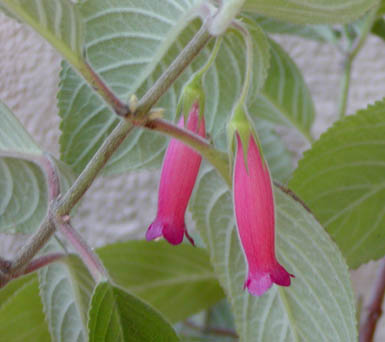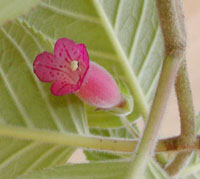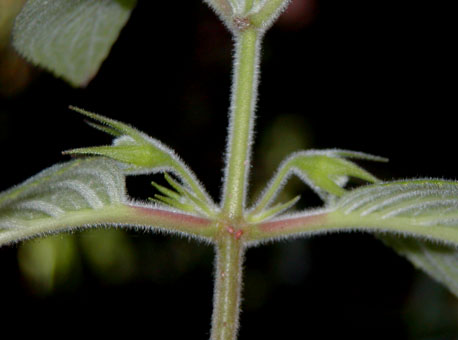|
Another species in the Sinningieae with flowers that hang vertically
is S. sellovii,
but in the latter species the stamens project beyond
the tube (are exserted).
V. pendula is easily distinguished from
Sinningia sellovii in other
ways too: it has no tuber, and its leaves are flexible and hairy and relatively
smooth, rather than stiff and quilted like those of
S. sellovii.
The latter's flowers are mostly borne on an
extended axis,
rather than axillary cymes.
The picture also shows that the petioles are reddish on top, but plain green beneath.
|
Plant Description
|
| Growth |
Indeterminate |
| Habit |
Upright shrub |
| Leaves |
Green, with fine reflective hairs on leafback.
Petioles are red on top. |
| Dormancy |
No tuber |
Flowering
|
| Inflorescence |
axillary cymes |
| Flowering |
Late autumn |
| Flower |
Tubular, pinkish red, about 2 inches [5 cm] long, hanging vertically |
Horticultural aspects
|
| From seed |
45 months to bloom, under my conditions |
| Hardiness |
This plant has survived 32 F (0 C) in my back yard.
At 30 F (-1 C), the leaves were killed [December 2006].
In January 2007, the plant was exposed to 27 F (-3 C), and is probably dead. |
| Recommended? |
Not unless you have a lot of outdoor space. |
Botany
|
| Taxonomic group |
The free-calyx-lobe vanhouttea clade. |
| Nectaries |
Five glands. |


